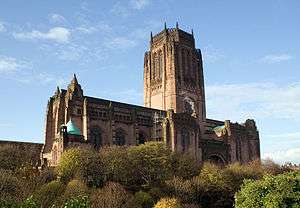Albany (Liverpool)
- For the building with the same name in London, see Albany (London)
| Albany Building | |
|---|---|
|
Albany Building | |
| Location | Old Hall Street, Liverpool, Merseyside, England |
| Coordinates | 53°24′31″N 2°59′33″W / 53.4087°N 2.9926°WCoordinates: 53°24′31″N 2°59′33″W / 53.4087°N 2.9926°W |
| OS grid reference | SJ 341 907 |
| Built | 1856 |
| Built for | Richard Naylor |
| Architect | J. K. Colling |
Listed Building – Grade II* | |
| Designated | 12 July 1966 |
| Reference no. | 1208630 |
 Location in Liverpool | |
The Albany Building is in Old Hall Street, between Ormond Street and George Street, in Liverpool, Merseyside, England. Built originally as a meeting place for cotton brokers, it has since been converted into apartments. It is recorded in the National Heritage List for England as a designated Grade II* listed building.[1]
History
The Albany was erected in 1856 for Richard Naylor, a banker, and designed by J.K. Colling. It was built as a meeting place for cotton brokers, and contained offices and meeting rooms, together with warehousing facilities in the basement. It is one of the earliest examples of Victorian offices in Liverpool. The central courtyard was originally uncovered, to provide good light for the brokers to examine their cotton samples.[2] It was converted into apartments in 2004–05.[3]
Architecture
The building is in three storeys plus a basement, and its front on Old Hall Street has eleven bays. The basement is constructed in rusticated granite, the ground floor in rusticated ashlar, and the upper storeys in brick with stone dressings. The round-arched entrance is in the central bay, and consists of a granite surround with a keystone, carvings in the spandrels. Over this is a frieze and a segmental pediment. The ground floor windows are three-light sashes, with segmental heads and keystones. Above the windows is a cornice. The first floor windows also have segmental heads; these contain carved archivolts and tympana. The windows in the top floor are smaller, with stone architraves and keystones. Along the top of the building is a carved frieze, a cornice supported by brackets, and a balustraded parapet.[1] The side elevations are plainer, and still include cast iron hoists. The main entrance contains cast iron gates made to look like wrought iron.[3] Inside is a coffered and barrel vaulted passage leading to the central courtyard, containing red granite columns and decorated with elaborate plasterwork.[1]
See also
References
- 1 2 3 Historic England, "The Albany, Liverpool (1208630)", National Heritage List for England, retrieved 27 June 2013
- ↑ Pye, Ken (2011), Discover Liverpool, Liverpool: Trinity Mirror Media, p. 81, ISBN 978-1-906802-90-5
- 1 2 Pollard, Richard; Pevsner, Nikolaus (2006), Lancashire: Liverpool and the South-West, The Buildings of England, New Haven and London: Yale University Press, pp. 328–329, ISBN 0-300-10910-5
-

The Albany, Entrance
-

The Albany, Courtyard



